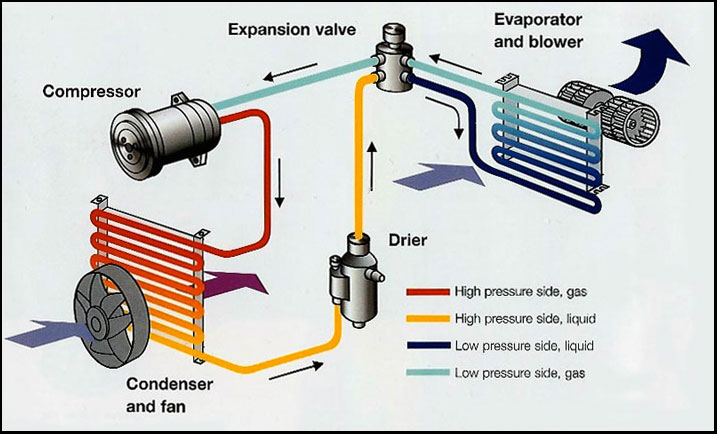
Almost all cars nowadays have air conditioning systems, yet very few car owners have any idea how it operates or what to do if it doesn't. Summer is bearing down on us, so it's a good idea to have your AC system in proper working order.
CAUTION: Before we go any further, you should know that a problem which requires opening the pressurized gas system is best left to the professionals. They have the necessary training and tools required to do the job. Mike Duman Auto Superstore provides for this service and is more than willing to help. There are, however, a whole host of common problems that can fall well within the capabilities of a backyard mechanic.
The gist of the AC system is that it moves heat by making a liquid to become a gas, thus absorbing heat, and then returning that gas into a liquid, where it gives off heat. This liquid is often to referred to as refrigerant or more commonly known as Freon. Newer vehicles use more eco-friendly types of Freons, but all can become quickly toxic when exposed to open flame or even hot metals. Always use caution.
The Five Basic Parts
Every AC system has five necessary parts. Here are all of them and a short description of what they do.
- Compressor - The compressor takes low-pressure, cooling refrigerant and makes it hot by compressing it. Several pistons do the actual condensing while a V-belt connected to the engine drives it. There is also a clutch that disconnects it when the AC is off.
- Condenser - This part removes the heat from the high-pressure R-12, condensing it and turning it into a liquid in the process.
- Receiver-drier - Once the refrigerant is a liquid, it's stored in the receiver. It is passed through a filter to remove any impurities, as well as water. This refrigerant needs to remain dry as it turns into a corrosive substance known as a hydrochloric acid when it's mixed with water.
- Expansion valve - The expansion valve restricts the flow of refrigerant between it and the compressor. As the refrigerant is sprayed through its small orifice, it turns into a gas, absorbing heat.
- Evaporator - The evaporator is just like a radiator but in reverse. Instead of radiating heat, it will absorb it, keeping the whole AC system in balance.

Symptoms and Solutions
Now that you have a basic idea of how an AC system works, here are some common issues and how to fix them.
- If the fan isn't working, this is likely an electrical problem. You will have to replace the fuse, wire, or fan motor, as necessary.
- If the fan is operating, but it's not producing any cold air, it could mean one of several things. First, it could be a problem with the compressor. Check if the V-belt is broke, and if it is, you will have to replace it. It could also be that the compressor itself is not working - in which case you will have to consult a mechanic. This issue could also be indicative of a lack of refrigerant or that the system is clogged.
- If the fan is working, but it produces too little cold air, it could mean that the V-belt or the clutch are slipping. It could also indicate low levels of refrigerant, or that there is water or air contamination within the system. Clogging of the condenser or evaporator may also be to blame.
Some of these issues can be resolved by someone who can find their way around a car. But if you don't consider yourself one or you don't have the time, you can contact Mike Duman Auto Superstore for a maintenance or service check, either by calling 888-239-2076 or by visiting our contact page.
